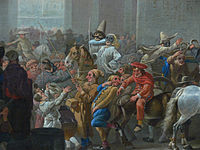Mardi Gras
| Mardi Gras | |
|---|---|
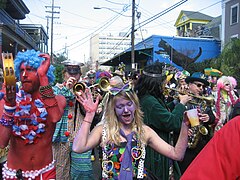 Celebrations in New Orleans, Louisiana, U.S. | |
| Also called | Fat Tuesday, Shrove Tuesday, Pancake Tuesday |
| Type | Christian, Cultural |
| Significance | Celebration period before fasting season of Lent |
| Celebrations | Parades, parties |
| Date | Day before Ash Wednesday, 47 days before Easter, 2 days after Shrove Sunday |
| 2023 date | February 21 |
| 2024 date | February 13 |
| 2025 date | March 4 |
| 2026 date | February 17 |
| Frequency | Annual |
| Related to | Shrove Tuesday, Carnival, Shrove Monday, Pre-Lent, Ash Wednesday, Lent, Užgavėnės, Maslenitsa, |
Mardi Gras (UK: /ˌmɑːrdi ˈɡrɑː/, US: /ˈmɑːrdi ɡrɑː/;[1][2] also known as Shrove Tuesday) is the final day of Carnival (also known as Shrovetide or Fastelavn); it thus falls on the day before the beginning of Lent on Ash Wednesday.[3] Mardi Gras is French for "Fat Tuesday", reflecting the practice of the last night of consuming rich, fatty foods in preparation for the Christian fasting season of Lent, during which the consumption of such foods is avoided.[4]
Related popular practices are associated with Carnival celebrations before the fasting and religious obligations associated with the penitential season of Lent. In countries such as the United Kingdom, Mardi Gras is more usually known as Pancake Day or (traditionally) Shrove Tuesday, derived from the word shrive, meaning "to administer the sacrament of confession to; to absolve".[5]
Background
During the liturgical season of Lent, some Christians abstain from the consumption of certain foods such as meat, eggs, dairy products, and alcoholic beverages. Most Christian denominations observe the tradition of Lent; exceptions include many churches within the Anabaptist, Baptist, Methodist, and Reformed traditions.[6][7][8][9][10] Shrovetide provided Christians with the opportunity to use up these foods prior to the start of the 40-day fasting season of Lent.[11][12][13] Prior to the 6th century, Lent was normatively observed through the practice of the Black Fast, which enjoins fasting from food and liquids, with the allowance of one vegetarian meal and water after sunset.[12][13] The tradition of pancake breakfasts during Shrovetide, as well as that of pancake races, owes itself to this practice of "using up the surplus eggs, milk and butter" prior to Lent.[11][14] In many Christian parish churches, both Protestant and Roman Catholic, a popular Shrove Tuesday tradition is the ringing of the church bells (on this day, the toll is known as the Shriving Bell) "to call the faithful to confession before the solemn season of Lent" and for people to "begin frying their pancakes".[15][16][17] As such, a hallmark of Shrovetide is the opportunity for a last round of merrymaking associated with Mardis Gras before the start of the somber Lenten season.[18][19][4] The last day of Shrovetide, Mardi Gras (Fat Tuesday), is named as such "because people felt bloated having eaten up all the rich foods before Lent" in order to prepare for the coming season of repentance.[4]
Traditions
The festival season varies from city to city; Mardis Gras often refers to the last day of Shrovetide (or Fastelavn or Carnival), thus being synonymous with Shrove Tuesday.[4] Some traditions, such as the one in New Orleans, Louisiana, consider Mardi Gras to stretch the entire period from Twelfth Night (the last night of Christmas which begins Epiphany) to Ash Wednesday.[20][21] Others treat the final three-day period before Ash Wednesday as the Mardi Gras.[22]
In Mobile, Alabama, Mardi Gras–associated social events begin in November, followed by mystic society balls[20][23] New Year's Eve, followed by parades and balls in January and February, celebrating up to midnight before Ash Wednesday. In earlier times, parades were held on New Year's Day.[20] Carnival (or Fastelavn or Shrovetide) is an important celebration in Lutheran, Anglican and Catholic European nations.[5][18]
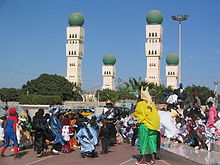

Belgium
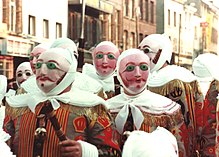
The three-day Carnival of Binche, near Mons, is one of the best known in Belgium. It takes place around Shrove Tuesday (or Mardi Gras) just before Lent. Performers known as Gilles wear elaborate costumes in the national colours of red, black and yellow. During the parade, they throw oranges at the crowd.[24] In 2003, it was recognized by UNESCO as one of the Masterpieces of the Oral and Intangible Heritage of Humanity.[25]
Czech Republic
In the Czech Republic, it is a folk tradition to celebrate Mardi Gras, which is called Masopust (meat-fast, i.e. beginning of the fast there). There are celebrations in many places including Prague,[26] but the tradition also prevails in villages such as Staré Hamry, whose door-to-door processions made it to the UNESCO World Intangible Cultural Heritage List.[27]
Germany
The celebration on the same day in Germany knows many different terms, depending on the region, such as Fastnacht, meaning the eve of the fast that takes place during Lent, or Veilchensdienstag (Violet Tuesday), as it is called in the Lower Rhine region. The celebrations often stretch from Epiphany, known in sections of Germany as Heilige Drei Könige, through the night before Ash Wednesday, and is variously known by different names, such as Karneval or Fasching in Germany, Austria and German-speaking areas of Switzerland. It is also often referred to as the "fifth season", which traditionally begins with Hoppeditz Erwachen (the waking of Hoppeditz, the Fool who embodies the Karneval season) on 11 November at 11:11 AM (11/11 11:11).[citation needed] and ends with his comic funeral mass on Fastnacht.
Karneval is filled with large banquets held by the various organizing societies and generally comes to a climax beginning on what is variously known as Schmutziger Donnerstag or Fetter Donnerstag (Fat Thursday), Unsinniger Donnerstag (Nonsense Thursday), Altweiberfastnacht, Greesentag and others. In standard German, schmutzig means "dirty", but in the Alemannic dialects schmotzig means "lard" (Schmalz), or "fat";[28] thus "Greasy Thursday", as remaining winter stores of lard and butter used to be consumed at that time, before the fasting began. Altweiberfastnacht often featured women wearing men's clothing and assuming their roles. In many towns across the state of North Rhine Westphalia, a ritual "takeover" of the town halls by local women has become tradition.
Italy
In Italy Mardi Gras is called Martedì Grasso (Fat Tuesday). It is the main day of Carnival along with the Thursday before, called Giovedí Grasso (Fat Thursday), which ratifies the start of the celebrations. The most famous Carnivals in northern Italy are in Venice, Viareggio and Ivrea, while in the southern part of Italy the Sardinian Sartiglia and the intriguing apotropaic masks, especially the mamuthones, issohadores, s'urtzu (and so on), are more popular, belonging to a very ancient tradition. Ivrea has the characteristic "Battle of Oranges" that finds its roots in medieval times. The Italian version of the festival is spelled Carnevale.[29]
Sweden
In Sweden the celebration is called Fettisdagen, when fastlagsbulle is eaten, more commonly called Semla. The name comes from the words "fett" (fat) and "tisdag" (Tuesday). Originally, this was the only day one should eat fastlagsbullar.[30]
United States
While not observed nationally throughout the United States, a number of historically ethnically French cities and regions in the country have notable celebrations. Mardi Gras arrived in North America as a French Catholic tradition with the Le Moyne brothers,[31] Pierre Le Moyne d'Iberville and Jean-Baptiste Le Moyne de Bienville, in the late 17th century, when King Louis XIV sent the pair to defend France's claim on the territory of Louisiane, which included what are now the U.S. states of Alabama, Mississippi, Louisiana and part of eastern Texas.[31]
The expedition, led by Iberville, entered the mouth of the Mississippi River on the evening of 2 March 1699 (new style), Lundi Gras. They did not yet know it was the river explored and claimed for France by René-Robert Cavelier, Sieur de La Salle in 1683. The party proceeded upstream to a place on the east bank about 60 miles (100 km) downriver from where New Orleans is today, and made camp. This was on 3 March 1699, Mardi Gras, so in honour of this holiday, Iberville named the spot Point du Mardi Gras (French: "Mardi Gras Point") and called the nearby tributary Bayou Mardi Gras.[32]
Bienville went on to found the settlement of Mobile, Alabama in 1702 as the first capital of French Louisiana.[33] In 1703 French settlers in Mobile established the first organised Mardi Gras celebration tradition in what was to become the United States.[31][34][35][36] The first informal mystic society, or krewe, was formed in Mobile in 1711, the Boeuf Gras Society.[34] Then came the Striker's Independent Society in 1842, followed by the oldest parading mystic society the Order of Myths or "OOMs" in 1867.
In 1720, Biloxi had been made capital of Louisiana. The French Mardi Gras customs had accompanied the colonists who settled there.[31]
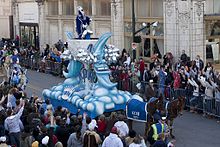
In 1723, the capital of Louisiana was moved to New Orleans, founded in 1718.[33] The first Mardi Gras parade held in New Orleans is recorded to have taken place in 1833 with Bernard de Marigny funding the first organized parade, tableau, and ball. The tradition in New Orleans expanded to the point that it became synonymous with the city in popular perception, and embraced by residents of New Orleans beyond those of French or Catholic heritage. Mardi Gras celebrations are part of the basis of the slogan Laissez les bons temps rouler ("Let the good times roll"), as floats "roll."[31][failed verification]
Festivities formally began in 1853 when a group of Protestant Anglo-Americans, some members of Mobile Mystic Societies, formed the first "old-line" krewe, The Mistick Krewe of Comus, based on Bernard de Marigny's 1833 parade of paper-mached wagons, a formal tableau vivant and presentation of debutants, followed by a formal ball. The Twelfth Night Revelers were formed in 1870, again with ties to Mobile, but no longer stage a parade, just tableau and ball. The Knights of Momus and Rex came about in 1872, with the last of the old-line krewes the Krewe of Proteus being formed 10 years later. Of these 5 groups only Rex and Proteus still formally parade, with the Knights of Chaos replacing Momus.
The parades of the largest krewes (colloquially known as "super krewes") came later, during the 1960s/70's, and traditionally occur immediately prior to and on Shrove Tuesday, including those of Endymion (Saturday, which also culminates with a concert event at Caesars Superdome), Bacchus (Sunday), and Zulu and Rex (Tuesday).
Other cities along the Gulf Coast with early French colonial heritage, from Pensacola, Florida; Galveston, Texas; to Lake Charles and Lafayette, Louisiana; and north to Natchez, Mississippi and Alexandria, Louisiana, have active Mardi Gras celebrations.[citation needed]
Galveston's first recorded Mardi Gras celebration, in 1867, included a masked ball at Turner Hall (Sealy at 21st St.) and a theatrical performance from Shakespeare's "King Henry IV" featuring Alvan Reed (a justice of the peace weighing in at 350 pounds) as Falstaff. The first year that Mardi Gras was celebrated on a grand scale in Galveston was 1871 with the emergence of two rival Mardi Gras societies, or "Krewes" called the Knights of Momus (known only by the initials "K.O.M.") and the Knights of Myth, both of which devised night parades, masked balls, exquisite costumes and elaborate invitations. The Knights of Momus, led by some prominent Galvestonians, decorated horse-drawn wagons for a torch lit night parade. Boasting such themes as "The Crusades", "Peter the Great", and "Ancient France", the procession through downtown Galveston culminated at Turner Hall with a presentation of tableaux and a grand gala.[citation needed]
In the rural Acadiana area, many Cajuns celebrate with the Courir de Mardi Gras, a tradition that dates to medieval celebrations in France.[37]
St. Louis, Missouri, founded in 1764 by French fur traders, claims to host the second largest Mardi Gras celebration in the United States.[38] The celebration is held in the historic French neighborhood, Soulard, and attracts hundreds of thousands of people from around the country.[39] Although founded in the 1760s, the St. Louis Mardi Gras festivities only date to the 1980s.[40] The city's celebration begins with "12th night," held on Epiphany, and ends on Fat Tuesday. The season is peppered with various parades celebrating the city's rich French Catholic heritage.[41]
Costumes

Mardi Gras, as a celebration of life before the more-somber occasion of Ash Wednesday, nearly always involves the use of masks and costumes by its participants, and the most popular celebratory colors are purple, green, and gold. In New Orleans, for example, these often take the shape of fairies, animals, people from myths, or various Medieval costumes[42] as well as clowns and Indians (Native Americans).[43]
Many costumes today are simply elaborate creations of colored feathers and capes. Unlike Halloween costumery, Mardi Gras costumes are not usually associated with such things as zombies, mummies, bats, blood, and the like, though death may be a theme in some. The Venice tradition has brought golden masks into the usual round of costumes.[44]
Exposure by women

Although the Church teaches that it is sinful and that it contravenes the Christian standards of modesty,[45][46] the practice of some women exposing their breasts during Mardi Gras in New Orleans, US, has been documented since 1889, when the Times-Democrat decried the "degree of immodesty exhibited by nearly all female masqueraders seen on the streets." The practice was mostly limited to tourists in the upper Bourbon Street area.[47][48] In the crowded streets of the French Quarter, generally avoided by locals on Mardi Gras Day, flashers on balconies cause crowds to form on the streets.[citation needed]
In the last decades of the 20th century, the rise in producing commercial videotapes catering to voyeurs helped encourage a tradition of women baring their breasts in exchange for beads and trinkets. Social scientists studying "ritual disrobement" found, at Mardi Gras 1991, 1,200 instances of body-baring in exchange for beads or other favors.[48]
See also
- Carnaval de Ponce
- Boeuf gras
- Fantasy Fest
- Fat Thursday, a similar traditional Christian feast associated with the celebration of Carnival.
- Maslenitsa
- Shrove Tuesday
- Sydney Gay and Lesbian Mardi Gras
- Tsiknopempti
- Užgavėnės
References
- ^ Wells, John C. (2008). Longman Pronunciation Dictionary (3rd ed.). Longman. ISBN 978-1-4058-8118-0.
- ^ Jones, Daniel (2011). Roach, Peter; Setter, Jane; Esling, John (eds.). Cambridge English Pronouncing Dictionary (18th ed.). Cambridge University Press. ISBN 978-0-521-15255-6.
- ^ "Mardi Gras (n.)". Oxford English Dictionary (Online ed.). Oxford University Press. doi:10.1093/OED/9489225210. (Subscription or participating institution membership required.)
- ^ a b c d Rose, David (1995). Christianity. Folens Limited. p. 9. ISBN 978-1-85276-765-5.
Shrove Tuesday was the day when all the luxury foods were eaten up. These included meat, eggs, milk and fine flour. People also went to church and confessed their sins. Today, many Christians give up 'something' for Lent, while others occupy their time with charitable works. In other parts of the world the day is called Fat Tuesday (or 'Mardi Gras') because people felt bloated having eaten up all the rich foods before Lent. Mardi Gras celebrations are often very elaborate, involving costumes and parties.
- ^ a b Melitta Weiss Adamson, Francine Segan (2008). Entertaining from Ancient Rome to the Super Bowl. ABC-CLIO. ISBN 9780313086892.
In Anglican countries, Mardis Gras is known as Shrove Tuesday—from shrive meaning "confess"—or Pancake Day—after the breakfast food that symbolizes one final hearty meal of eggs, butter, milk and sugar before the fast. On Ash Wednesday, the morning after Mardi Gras, repentant Christians return to church to receive upon the forehead the sign of the cross in ashes.
- ^ "Question & Answer: Should we Observe Lent?". Willow Grove, Pennsylvania: The Orthodox Presbyterian Church. 2024. Retrieved 3 November 2024.
Those inheriting a Reformed theology (which would include the OPC) have adopted the stance that the church is only to practice in worship what the Bible actually establishes, often called the 'regulative principle of worship.' Many in the Reformed tradition would exclude the practice of Lent on this basis—it lacks scriptural warrant.
- ^ Benedict, Philip (2002). Christ's Churches Purely Reformed: A Social History of Calvinism. New Haven: Yale University Press. pp. 118, 496. ISBN 0-300-08812-4.
- ^ Mennonite Stew – A Glossary: Lent. Third Way Media. Retrieved 3 November 2024.
Traditionally, Mennonites did not observe Lent, and only recently have more modern Mennonite churches started to focus on the six week season preceding Easter.
- ^ Brumley, Jeff (12 March 2012). "Lent not just for Catholics, but also for many denominations, Baptists and other evangelicals". The Florida Times-Union. Jacksonville, Florida. Retrieved 3 November 2024.
- ^ Moore, Scott (2008). "The Predicament and the Promise for Young Baptist Scholars". In Ward, Roger; Gushee, David (eds.). [978-0881461046 The Scholarly Vocation and the Baptist Academy: Essays on the Future of Baptist Higher Education]. Macon, Georgia: Mercer University Press. p. 143.
In most Baptist churches, Lent is non-existent, and Advent is merely the 'pre-Christmas' wind-up.
{{cite book}}: Check|url=value (help) - ^ a b Campbell, Georgina (May 2005). The Best of Irish Breads and Baking: Traditional, Contemporary and Festive. Georgina Campbell Guides. p. 106. ISBN 978-1-903164-15-0.
Until relatively recently, the Lenten fast was taken so seriously in Ireland that it meant abstaining not only from meat but also eggs and all milk products. The tradition of making pancakes on Shrove Tuesday (the day before Ash Wednesday) came about as a practical way of using up the surplus eggs, milk and butter which would otherwise go to waste. Most Irish families still make pancakes on Shrove Tuesday and the tradition of tossing pancakes not only survives but actually thrives, providing voter-friendly photo opportunities for politicians and commercial opportunities for the catering trade.
- ^ a b Butler, Alban (1839). The Moveable Feasts, Fasts, and Other Annual Observances of the Catholic Church. Dublin: James Duffy. pp. 144–146.
The primitive Christians in Lent broke their fast only after sunset, and then usually only with herbs, roots, and bread. At least all were obliged to abstain not only from flesh meat, but also from fish, and whatever had life; also whatever is derived from flesh, as eggs, milk, cheese, butter, according to the ancient canon. Likewise from wine, which in the primitive ages was no less forbidden on all fasting days than the use of flesh meat itself ... Some mitigations were introduced in part of abstinence in the sixth century ... Fish was in the same age allowed, but not of the dearer and more dainty kinds.
- ^ a b Butler, Alban (1774). The Moveable Feasts, Fasts, and Other Annual Observances of the Catholic Church. C. Kiernan. p. 257.
It is undoubted, that anciently to drink on fasting days was no less forbid than to eat, only in the refection after sunset.
- ^ Collins, Tony; Martin, John; Vamplew, Wray (2005). Encyclopedia of Traditional British Rural Sports. Psychology Press. p. 202. ISBN 978-0415352246.
The association between pancakes and Shrove Tuesday appears to have its origins in the fact that the pancakes used up food such as butter, eggs and fat that were prohibited during Lent, which begins the following day on Ash Wednesday. ... Pancakes have been eaten on Shrove Tuesday since at least the sixteenth century. In some parishes, it was the custom for the church bell to ring at noon as the signal for people to begin frying their pancakes.
- ^ "What Is the Meaning and History of Shrove Tuesday?". Christianity.com. 13 February 2024. Retrieved 7 April 2024.
In many Protestant and Roman Catholic Christian churches, a popular Shrove Tuesday ritual is the ringing of the church bells (on this day, known as the Shriving Bell) "to call the faithful to confession before the solemn season of Lent" and for people to "begin frying their pancakes."
- ^ Cocks, Alfred Heneage (1897). The church bells of Buckinghamshire: their inscriptions, founders, and uses, and traditions; &c. Jarrold & sons. p. 276.
- ^ Pulleyn, William (1828). The Etymological Compendium, Or Portfolio of Origins and Inventions. Richard Griffin and Company. p. 192.
- ^ a b "Shrovetide". Church of Denmark. Retrieved 8 February 2021.
- ^ Beadle, Richard (17 March 1994). The Cambridge Companion to Medieval English Theatre. Cambridge University Press. p. 69. ISBN 9780521459167.
One of these was the pre-Lent Carnival extravaganza of Shrovetide, though this seems to have been celebrated to a much lesser extent in Britain than it was (and still is) on the continent: however, we know of English Shrovetide plays, and Mankind bears signs of being one of them (335).
- ^ a b c "Mardi Gras Terminology". Mobile Bay Convention & Visitors Bureau. Archived from the original on 9 December 2007. Retrieved 18 November 2007.
- ^ Wilds, John; Charles L. Dufour; Walter G. Cowan (1996). Louisiana, Yesterday and Today: A Historical Guide to the State. Baton Rouge: LSU Press. p. 157. ISBN 978-0807118931. Retrieved 11 December 2015.
- ^ Bratcher, Dennis (7 January 2010). "The Season of Lent". Christian Resource Institute. Retrieved 25 June 2016.
- ^ "Mobile Carnival Association, 1927", MardiGrasDigest.com, 2006, webpage: mardigrasdigest-Mobile "Mobile Carnival Association". Archived from the original on 7 March 2006. Retrieved 12 March 2018.
- ^ "The best Belgian folklore festivals". expatica.com. Retrieved 25 November 2012.
- ^ Cole, Leanne Logan & Geert (2007). Lonely Planet Belgium & Luxembourg (3. ed.). Footscray (Victoria): Lonely Planet. p. 223. ISBN 978-1-74104-237-5.
- ^ "Mardi Gras in Bohemia-Prague". Archived from the original on 11 December 2021. Retrieved 18 January 2016 – via YouTube.
- ^ "Staročeský masopust Hamry". Retrieved 16 December 2017.
- ^ "Woher hat der Schmutzige Donnerstag seinen Namen?". Regionalzeitung Rontaler AG (in German). 17 February 2013. Retrieved 7 February 2015.
- ^ Killinger, Charles L. (2005). Culture and Customs of Italy. Greenwood Publishing Group. p. 94. ISBN 978-0313324895.
mardi gras in italy.
- ^ "Swedish semla: more than just a bun". Sweden.se. Archived from the original on June 6, 2011. Retrieved February 22, 2011.
- ^ a b c d e "New Orleans & Mardi Gras History Timeline " (event list), Mardi Gras Digest, 2005, webpage: MG-time Archived 24 November 2010 at the Wayback Machine
- ^ "9 Things You May Not Know About Mardi Gras". History.com. Retrieved 17 August 2017.
- ^ a b "Timeline 18th Century:" (events), Timelines of History, 2007, webpage: TLine-1700-1724: on "1702–1711" of Mobile.
- ^ a b "Carnival/Mobile Mardi Gras Timeline". Museum of Mobile. Retrieved 18 July 2012.
- ^ "Mardi Gras in Mobile" (history), Jeff Sessions, Senator, Library of Congress, 2006, webpage: LibCongress-2665.
- ^ "Mardi Gras" (history), Mobile Bay Convention & Visitors Bureau, 2007, webpage: MGmobile.
- ^ Barry Jean Ancelet (1989). Capitaine, voyage ton flag : The Traditional Cajun Country Mardi Gras. Center for Louisiana Studies, University of Southwestern Louisiana. ISBN 0-940984-46-6.
- ^ Geiling, Natasha. "Best Places to Celebrate Mardi Gras Outside of New Orleans". Smithsonian. Retrieved 11 February 2018.
- ^ Houser, Dave G. "7 big Mardi Gras celebrations (not in New Orleans)". chicagotribune.com. Retrieved 11 February 2018.
- ^ "Mardi Gras in St. Louis' Soulard Neighborhood". allaboutmardigras.com. Retrieved 12 February 2018.
- ^ "12th Night | Soulard Mardi Gras 2018". stlmardigras.org. St. Louis, MO. Retrieved 11 February 2018.
- ^ Lisa Gabbert (1999). Mardi Gras: A City's Masked Parade. The Rosen Publishing Group. p. 4. ISBN 978-0-8239-5337-0.
- ^ A Mardi Gras Dictionary. Pelican Publishing. p. 6. ISBN 978-1-4556-0836-2.
- ^ J.C. Brown (2008). Carnival Masks of Venice: A Photographic Essay. AAPPL Artists & Photographers Press, Limited. ISBN 978-1-904332-83-1.
- ^ O'Malley, Timothy P. (20 May 2022). Becoming Eucharistic People: The Hope and Promise of Parish Life. Ave Maria Press. p. 13. ISBN 978-1-64680-157-2.
- ^ Cuthbert, Chloe (19 February 2018). "Why We Celebrate Mardi Gras". Iron Ladies. Retrieved 17 April 2024.
And by the way, flashing is not only not required, it's discouraged.
- ^ Sparks, R. "American Sodom: New Orleans Faces Its Critics and an Uncertain Future". La Louisiane à la dérive. The École des Hautes Études en Sciences Sociales Coloquio. 16 December 2005.
- ^ a b Shrum, W. and J. Kilburn. "Ritual Disrobement at Mardi Gras: Ceremonial Exchange and Moral Order". Social Forces, Vol. 75, No. 2. (Dec. 1996), pp. 423–458.
External links
- Traditional Cajun Mardi Gras Celebrations
- Mardi Gras in Mobile, Encyclopedia of Alabama
- Where to Celebrate Mardi Gras Around the World – slideshow by The Guardian
- Fashion plates featuring historic Mardi Gras costumes from the Metropolitan Museum of Art Libraries

